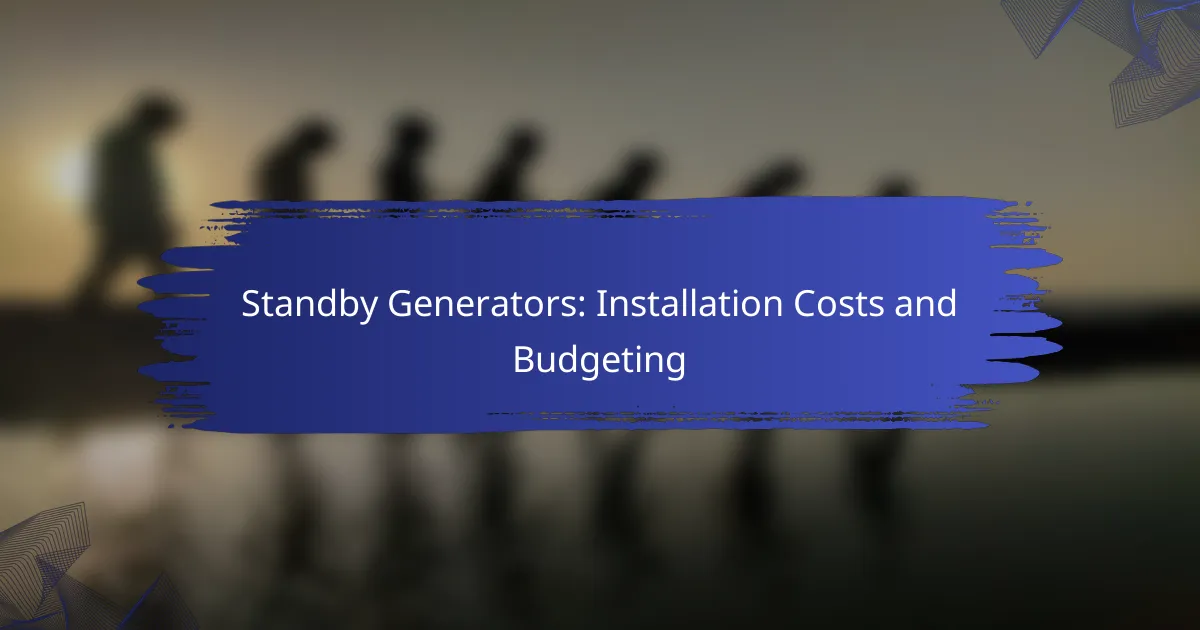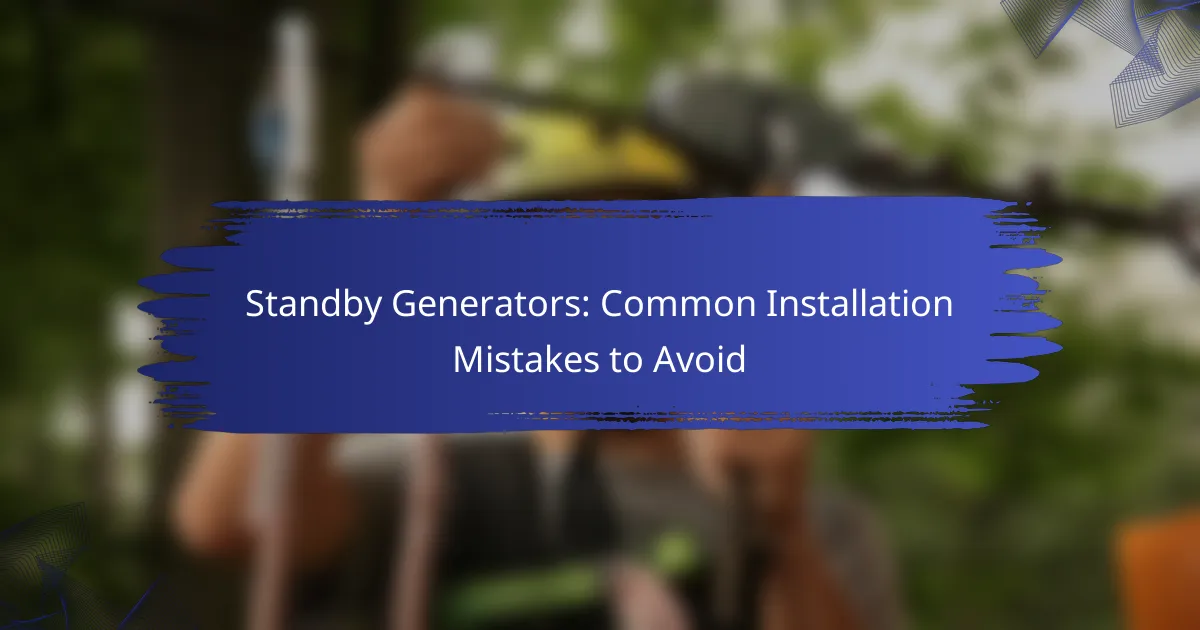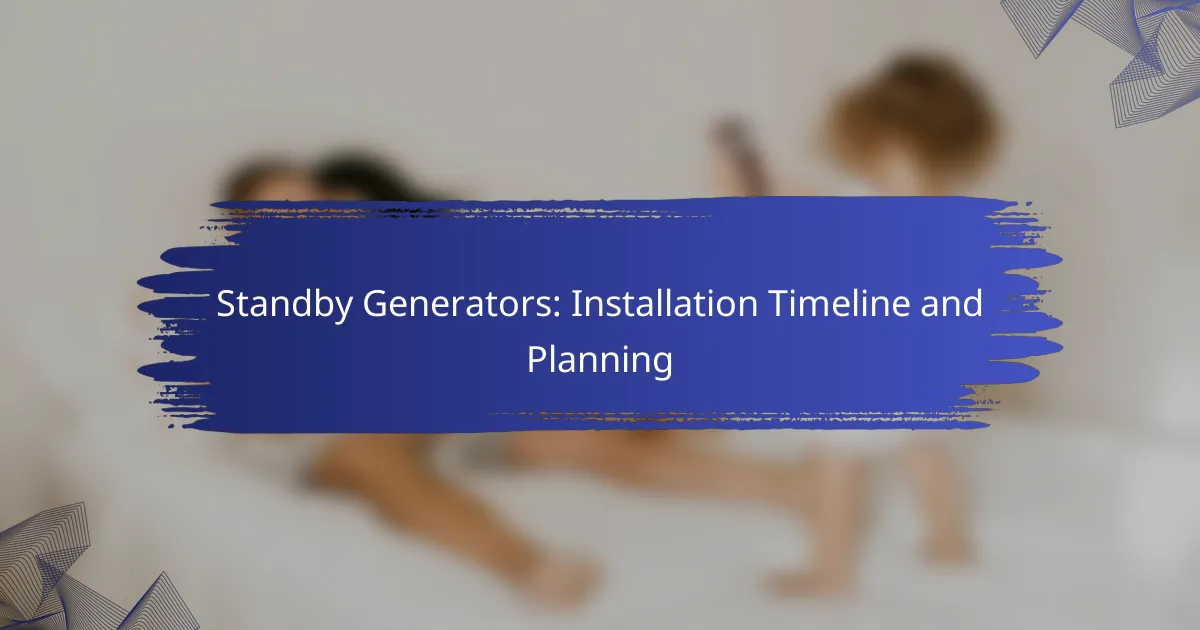When considering the installation of a standby generator, homeowners should anticipate costs ranging from several thousand to over ten thousand dollars, influenced by factors such as location and specific installation requirements. A comprehensive budget should encompass not only the initial purchase price and installation fees but also long-term maintenance expenses to ensure reliable performance over time.

What are the installation costs of standby generators in the United States?
The installation costs of standby generators in the United States typically range from several thousand to over ten thousand dollars, depending on various factors. Homeowners should budget for both the generator unit and the installation service, which can vary significantly based on location and specific requirements.
Average installation cost range
The average installation cost for standby generators generally falls between $5,000 and $15,000. This range includes the price of the generator itself, which can be anywhere from $2,000 to $10,000, along with labor and additional materials. Homeowners should expect to pay more in urban areas compared to rural locations due to higher labor costs.
Factors affecting installation costs
Geographical location also plays a significant role; areas with higher living costs typically have higher installation fees. Furthermore, the choice between a manual or automatic transfer switch can affect the overall price, with automatic systems generally costing more.
Cost breakdown by generator size
Generator size directly impacts installation costs. Smaller units, typically rated around 7-10 kW, may cost between $5,000 and $7,000 installed. Mid-range generators, around 11-20 kW, can range from $7,000 to $10,000, while larger units, exceeding 20 kW, often start at $10,000 and can exceed $15,000 depending on the complexity of the installation.
When selecting a generator size, consider your household’s power needs during outages. It’s advisable to consult with a professional to determine the appropriate size, as undersized generators may not effectively power essential appliances, leading to additional costs in the long run.

How to budget for a standby generator installation?
Budgeting for a standby generator installation involves understanding both the initial costs and ongoing expenses. It’s essential to consider the generator’s price, installation fees, and long-term maintenance to create a comprehensive budget.
Initial investment considerations
The initial investment for a standby generator typically ranges from a few thousand to over ten thousand USD, depending on the generator’s capacity and features. Key factors include the generator type, installation complexity, and any necessary permits or local regulations.
When budgeting, factor in additional costs such as transfer switches, electrical upgrades, and labor. It’s wise to obtain multiple quotes from licensed contractors to ensure competitive pricing and quality installation.
Long-term maintenance costs
Long-term maintenance costs for standby generators can vary but generally fall between a few hundred to a couple of thousand USD annually. Regular maintenance includes oil changes, battery replacements, and system checks to ensure reliability during outages.
Consider setting aside a maintenance fund to cover these expenses. Some manufacturers offer service plans that can help manage costs and ensure timely upkeep, which can be beneficial in the long run.
Financing options available
Financing options for standby generator installations can include personal loans, home equity lines of credit, or specialized financing programs from generator manufacturers. Many homeowners choose to finance to spread the initial costs over time.
Before committing to a financing option, compare interest rates and terms to find the most favorable deal. Some local utility companies may also offer rebates or incentives for energy-efficient generators, which can further reduce your overall expenses.

What are the best standby generator brands?
The best standby generator brands are known for their reliability, performance, and customer support. Leading names such as Generac, Briggs & Stratton, and Cummins offer a variety of models tailored to different power needs and budgets.
Generac generator models
Generac is one of the most recognized brands in the standby generator market, offering a wide range of models suitable for residential and commercial use. Their generators typically provide power outputs from around 7 kW to over 22 kW, making them versatile for various applications.
Popular Generac models include the Guardian Series, which features automatic transfer switches and mobile link monitoring. When considering a Generac generator, evaluate the size of your home and the essential appliances you want to power during an outage.
Briggs & Stratton generator options
Briggs & Stratton offers reliable standby generators that are particularly known for their ease of use and maintenance. Their models generally range from 8 kW to 20 kW, making them suitable for most residential needs.
The Fortress Series is a notable option, featuring a compact design and quiet operation. When selecting a Briggs & Stratton generator, consider the installation costs and ensure it meets local regulations for emissions and noise levels.
Cummins generator features
Cummins generators are recognized for their robust construction and advanced technology, often favored for larger homes or commercial settings. Their power outputs can range from 13 kW to over 50 kW, providing ample capacity for extensive electrical loads.
Key features of Cummins generators include a user-friendly control panel and remote monitoring capabilities. When choosing a Cummins model, assess your power requirements and the generator’s fuel efficiency to ensure it aligns with your budget and operational needs.

What permits are needed for standby generator installation?
Installing a standby generator typically requires various permits to ensure compliance with local building codes and safety regulations. These permits help ensure that the installation is safe, legal, and meets all necessary standards.
Local regulations overview
Local regulations for standby generator installation can vary significantly by municipality or state. It’s essential to check with your local building department to understand specific requirements, as some areas may have stricter codes than others. Regulations may include zoning laws, noise ordinances, and safety standards.
In many regions, the installation must comply with the National Electrical Code (NEC) and any local amendments. This ensures that the generator is safely connected to the electrical system and that it operates efficiently without posing hazards.
Common permit requirements
Common permits for standby generator installation often include electrical permits, building permits, and sometimes plumbing permits if a fuel line is involved. The electrical permit ensures that the generator is installed according to electrical codes, while the building permit verifies that the installation meets structural safety standards.
Homeowners should prepare to submit plans or specifications for the installation, which may include details about the generator’s size, location, and connection to the home. It is advisable to consult with a licensed contractor who can assist in navigating the permitting process and ensure compliance with all local laws.

How to choose the right standby generator?
Choosing the right standby generator involves assessing your power needs, considering fuel types, and evaluating noise levels. Each factor plays a crucial role in ensuring you select a generator that meets your requirements effectively and efficiently.
Power needs assessment
Start by determining the total wattage required to power your essential appliances during an outage. This typically includes refrigerators, heating or cooling systems, and medical equipment. A common approach is to list all devices and their wattage, then sum them up to find your baseline power needs.
For most households, standby generators range from 5,000 to 20,000 watts. If you anticipate needing power for high-wattage appliances, consider a generator on the higher end of this spectrum. Consulting with a professional can help ensure you account for all necessary devices.
Fuel type considerations
Standby generators typically run on natural gas, propane, or diesel. Natural gas is often preferred for its convenience and lower cost, while propane can be a good alternative if natural gas lines are unavailable. Diesel generators are generally more robust but may incur higher fuel costs.
Consider the availability of fuel sources in your area. For instance, if you live in a region prone to natural gas supply interruptions, a propane generator might be a more reliable choice. Additionally, think about storage requirements and the ease of refueling when selecting a fuel type.
Noise level factors
Noise levels can vary significantly between different generator models, with some operating quietly while others can be quite loud. Look for generators that specify their decibel rating, typically ranging from 50 to 70 dB, to find one that suits your noise tolerance.
For residential areas, consider models designed for quieter operation, especially if you have close neighbors. Some generators come equipped with soundproof enclosures or mufflers to minimize noise. Checking local regulations regarding noise levels can also help you avoid potential issues with your generator’s operation.

What are the installation steps for a standby generator?
Installing a standby generator involves several key steps, including site preparation, making electrical connections, and testing the system. Each step is crucial to ensure that the generator operates safely and effectively when needed.
Site preparation requirements
Before installation, the site must be properly prepared to accommodate the generator. This includes selecting a location that is level, well-drained, and at least several feet away from structures and windows to minimize noise and exhaust exposure.
Additionally, local regulations may dictate specific clearance requirements and zoning restrictions. It’s advisable to check with local authorities to ensure compliance with any building codes or permits needed for installation.
Electrical connections process
The electrical connections for a standby generator typically involve linking it to the home’s electrical panel and ensuring that the transfer switch is properly installed. This switch allows for seamless transition between grid power and generator power during outages.
Hiring a licensed electrician is recommended to handle these connections, as they must adhere to local electrical codes and safety standards. The cost for this service can vary, but budgeting a few hundred to over a thousand dollars is common depending on the complexity of the installation.
Testing and commissioning
Once the generator is installed and connected, thorough testing is essential to confirm that the system operates correctly. This includes running the generator under load to ensure it can handle the electrical demands of the home.
Commissioning should also involve checking the transfer switch functionality and ensuring that all safety features are operational. Regular maintenance checks should be scheduled to keep the generator in optimal working condition, which can help prevent issues during an actual power outage.

What are the common mistakes in budgeting for standby generators?
Common mistakes in budgeting for standby generators include underestimating installation costs, neglecting ongoing maintenance expenses, and failing to account for necessary permits. Proper planning and understanding of all associated costs can prevent budget overruns and ensure a smooth installation process.
Underestimating installation costs
Many homeowners overlook the full scope of installation costs when budgeting for standby generators. This can include expenses for electrical upgrades, concrete pads, and labor, which can significantly increase the overall price. It’s advisable to obtain multiple quotes from licensed contractors to get a realistic estimate.
Neglecting ongoing maintenance expenses
Budgeting should not only focus on the initial purchase and installation but also on ongoing maintenance costs. Regular servicing, oil changes, and potential repairs can add up over time. Setting aside a maintenance fund of around 10-15% of the initial generator cost annually can help manage these expenses effectively.
Failing to account for necessary permits
Many regions require permits for the installation of standby generators, which can incur additional fees. Ignoring these requirements can lead to fines or delays in installation. It’s essential to check local regulations and include permit costs in your budget to avoid unexpected financial burdens.










